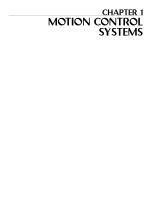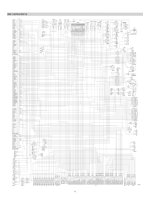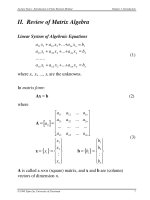CHAPTER 2: LIGHTNING PROTECTION
Bạn đang xem bản rút gọn của tài liệu. Xem và tải ngay bản đầy đủ của tài liệu tại đây (134.39 KB, 7 trang )
TM 5-811-3/AFM 88-9, Chap. 3
CHAPTER 2
LIGHTNING PROTECTION
2-1. Discussion
a. Lightning phenomena. The planet earth is simi-
lar to a huge battery continuously losing electrons to
the atmosphere. These electrons could be lost in less
than an hour unless the supply is continually replen-
ished. It is widely agreed among physicists and scien-
tists that thunderstorms occurring thousands of
times daily around the earth return electrons to
earth to maintain normal magnitude of electrons at or
near the surface of- the earth. The rate of electron
loss from earth, called the “air-earth ionic current”,
has been calculated to be 9 microampere for every
square mile of earth’s surface. Thunderstorms supply
electrons back to earth by an opposite electron poten-
tial gradient of perhaps 10 kilovolts per meter within
a thundercloud. This feedback forms a potential dif-
ference of from 10 to 100 megavolts in a single dis-
charge between the center of a cloud and earth.
These lightning discharges carry currents varying
from 10 to 345 kiloamperes to earth at an average
rate of 100 times per second with duration of less
than ½ second per flash. Each flash consists of up to
40 separate strokes, Each stroke of lightning lasting
for this brief instant releases about 250 kilowatt-
hours of energy-enough to operate a 100-watt light
bulb continuously for more than three months at the
rated voltage of the lamp. Lightning discharges do
not always bring electrons to earth, because so-called
positive ground-to-cloud strokes consist of low power
energy transmissions from earth to small negative
charge pockets in a thunder cloud. However, magni-
tudes of discharge voltages and currents are approxi-
mately the same from cloud to earth, and all occur
within the same discharge timeframes. Just before
the lightning flash, the ground within a radius of sev-
eral miles below the cloud becomes deficient in elec-
trons. Repelled by the army of electrons in the cloud
base, many of the free electrons on the ground are
pushed away. The result is that the ground beneath
the cloud base becomes more positively charged. As
the cloud moves, the positive charge region below
moves like its shadow. As the cloud charge balloons,
the pressure becomes so great that a chain reaction
of ionized air occurs. Ionization is the process of
separating air molecules into positive ions and nega-
tive electrons. This air which is normally a good elec-
trical insulator becomes a good conductor and allows
the cloud electrons to pierce the faulted insulation
and descend this newly created ionized air path be-
tween cloud and earth. The lightning flash starts
when a quantity of electrons from the cloud heads to-
ward earth in a succession of steps, pulsing forward
with an additional step every 50 microseconds
creating a faintly luminous trail called the initial or
stepped leader. As the leader nears the ground, its
effects create an ionized streamer which rises to
meet the advancing leader. When the two join, the
ionized air path between cloud and earth is
completed, and the leader blazes a faint trail to
earth. Immediately a deluge of electrons pour from
this lightning discharge channel creating the brilliant
main or return stroke that produces most of the light
we see, The motions of the leader and the main or re-
turn stroke appear to move in opposite directions,
but lightning is not an alternating current, since the
transferred electrical recharge current moves back to
earth.
b. Nonconventional systems. Nonconventional and
unacceptable systems include the so-called dissipa-
tion array, and those using radioactive lightning
rods, Radioactive lightning rods have been proven
less effective than passive air terminals in storm situ-
ations. These systems have not been recognized by
NFPA or UL. Use of these systems will not be
permitted unless specifically approved by the appro-
priate using agency. Dissipation arrays consist of two
types:
(1) A high tower with top-mounted dissipation
suppressor, and radial guy wire array. This type is
used on isolated high towers, antenna structures and
offshore facilities.
(2) A series of high towers located beyond a
given area to be protected and supported by a num-
ber of sharp pointed strands of barbed wire for the
protection array.
c. Code applicability. NFPA No. 78 is intended to
apply to the protection of ordinary buildings, special
occupancies, stacks, and facilities housing flammable
liquids and gases. The lightning protection code will
be utilized where lightning damage to buildings and
structures would cause large economic loss or would
prevent activities essential to the Department of De-
fense. NFPA No, 78 does not relate to the protection
of explosives manufacturing or storage facilities. Pro-
tection for these facilities will be in accordance with
paragraph 2–9. Since NFPA No. 78 does not pre-
scribe a comprehensive coverage pattern for each
type of facility required by the military departments
of the government, additional guidance is given in
this chapter. Temporary DOD storage facilities and
structure housing operations not regularly conducted
at a fixed location and other facilities specifically ex-
2-1
TM 5-811-3/AFM 88–9, Chap. 3
empted by the responsible using agency are not gov-
erned by the lightning protection code.
d. Effects of lightning discharges.
(1) General. When any building or structure is
located within a radius of several hundred feet from
the point where a lightning discharge will enter the
surface of the earth, the lightning discharge current
becomes so high that any building or structure within
this radius becomes vulnerable to immediate damage.
(2) Nature of damage. Damage may range from
minor defacement to the building to serious founda-
tion upheaval, fire and personnel casualties. Damage
control can be effective dependent on extent of fire-
proofing and lightning protection incorporated into
the project design. Although lightning strokes gener-
ate static discharges in the form of radio noise, it is
generally accepted that these cause only an instant of
interference to manmade electronic systems. In-
creased heating effects are also a factor since a light-
ning bolt increases the temperature of the lightning
channel to about 15,000 degrees C. This sudden in-
crease in temperature and pressure causes such an
abrupt expansion of air that any hazard type of at-
mosphere which comes within the ionized air path of
the lightning bolt becomes explosive. The explosive
nature of the air expansion of bolt channels can cause
physical disruption of structures located near the
lightning stroke.
Lightning discharges below the
earth surface sometimes fuse sand into fulgurates
which appear like glass tubes. Trees of 40 feet or
more in height are especially vulnerable targets for
attraction of lightning discharges, and are susceptible
to being totally destroyed.
e. Effective resistance to ground.
(1) The lightning protection system will be de-
signed to provide an electrical path to ground from
any point in the system, and that point will be of con-
siderably lower resistance than that otherwise avail-
able by use of the unprotected facility.
(2) Low resistance to ground is desirable for any
lightning protection system but not essential. This is
in conformance with NFPA No. 78 and MI L–HDBK–
419. Where low resistance to ground is mandatory,
grounding electrode patterns as described herein and
MIL-HDBK-419 will furnish ample length of electri-
cal path in contact with earth to dissipate each light-
ning discharge without damage to the protected
facility.
2–2. Limitations in use of lightning protection
a. General. Lightning protection will be installed
as part of the initial construction project, particularly
in view of long replacement time and high cost of
structures. Installation cost of lightning protection
systems during project construction is small when
compared to the cost of the installation as a whole.
Economic and operational considerations will be
made in determining the need for lightning protec-
tion system, unless otherwise directed by the using
agency. Unless lightning frequency at the project
site averages five or less thunderstorms per year, as
indicated in figure 2-1, lightning protection will be
provided for buildings and structures as follows:
(1) Buildings of four floors having elevator or
stairwell penthouses or other similar projections
above roof.
(2) Buildings of five floors or more with or with-
out projections above roof.
(3) Structures such as steel towers, aluminum
and reinforced concrete towers, and flagpoles with-
out inherent grounding, and smoke-stacks and stee-
ples of 50-foot elevation or more above lowest point
of contact with finished grade.
b. Other applications. Special consideration will be
given in determining need for lightning protection as
follows:
(1) Whether building is manned, and there is in-
herent hazard to personnel.
(2) Whether building contains explosive or haz-
ardous areas or rooms, weapons systems technical
equipment, or security communication equipment.
(3) If an unprotected building is destroyed by
lightning, the length of outage which can be tolerated
until replacement is made. This includes the restora-
tion of high priority facilities such as water supply,
weapons systems, police and security intelligence
communications, strategic communication system op-
erating components.
(4) Replacement of building contents and value
thereof.
2–3. Air terminals.
The purpose of air terminals is
to intercept lightning discharges above facilities. Air
terminals will be in accordance with UL 96, and 96A,
NFPA No. 78 or MIL–HDB-419. Where building
roof is not metal and building construction includes
steel framing, air terminal connection assemblies will
conform generally to figure 2-2.
2-4. Grounding
a. General. Grounding generally will conform to
NFPA No. 78, except as required by this manual or
by the using agency. Guidance for grounding for pur-
poses, such as electromagnetic pulse (EMP), electro-
magnetic interference shielding, NASA and HQDCA
electronic facility grounding, are subjects of other en-
gineering manuals which govern grounding require-
ments. Those grounding systems will also serve as
grounding of the lightning protection system. Where
separate systems are installed such systems will be
bonded below grade to any other independently in-
stalled exterior grounding system such as for electro-
2-2
125° 50° 120°
115°
110° 105”
100” 95°
90°
85° 80°
75° 50° 70”
65°
115”
110° 105°
100”
95°
90°
85°
80”
National Oceanographic and Atmospheric Administration
Figure 2-1. Mean number of thunderstorms--annual
TM 5-811-3/AFM 88–9, Chap. 3
magnetic shielding not suitable for complete lightning
protection system. However, exterior protection
grounding system will be bonded to static electricity
exterior grounding system.
b. Ground rods. Ground rods will be not less than
10 feet in length, nor less than ¾-inch diameter pipe
or equivalent solid rod. Ground rods will be located
clear of paved surfaces,
walkways, and roadways.
Rods will be driven so that tops are at least six
inches below finished grade, and three to eight feet
beyond perimeter of building foundation. Where
ground rods are used with a counterpoise, tops will
be driven to same elevation as counterpoise below
finished grade. Exact location of rods must give pref-
erence to use of moist earth. Contact with chemically
injurious waste water or other corrosive soils wiIl be
avoided. Where avoidance of chemically injurious or
corrosive soils is impracticable, use of stainless steel
rods and magnesium-anode protection will be consid-
ered. Driving stud bolts will be used for driving, and
couplings will be used for sectional rods. Where
buried metal pipes enter a building, the nearest
ground rod will be connected thereto.
c. Earth electrode subsystem. Each earth electrode
subsystem or counterpoise will consist of one or more
closed loops or grid arrangement of No. 1/0 AWG
bare copper conductors installed around facility pe-
rimeter not less than 2 feet below earth surface.
Larger conductors should be used when installed in
highly corrosive soils. A second loop, if used, should
not be less than 10 feet beyond the first and inner
loop. At least 2 ground rods should be provided at
each corner of each counterpoise loop where earth-
seeking current tend to concentrate. Counterpoise
ROOF RIDGE
LOCK NUTS OR
COUPLING
R
s
P
CONDUCTOR
US Army Corps of Engineers
Figure 2–2. Typical air terminal assembly using steel, framing as
protective system conductor
2-4
will extend not less than 3 feet nor more than 8 feet
beyond the perimeter of building walls or footings.
Conductor ends, connections to down conductors,
tops of ground rods
j
and crossovers will reconnected
for electrical continuity. Figure 2-3 illustrates a be-
low grade weapons system facility counterpoise. Pat-
tern will be as required in this manual or as required
by using service.
d. Radials. A radial system of grounding consists
of one or more No. 1/0 AWG copper conductors not
less than 12 feet long, extending away from each
ground rod or grounding connection. The use of mul-
tiple radials is an effective form of grounding, offer-
ing substantially lower reactance to the high fre-
quency of lightning current wave fronts than do
single straight conductors. Installation of grounding
radials will take advantage of crags and cracks in
surface rock formations in obtaining maximum avail-
able earth cover. Connections of radials to down con-
ductors will be made so as to insure electrical
continuity.
FINISHED GRADE
TM 5-811-3/AFM 88–9, Chap. 3
2-5. Nonreinforced concrete or wood frame
buildings.
Lightning protection will be provided on
outside of exterior surfaces without reliance upon
components of building for conductors. Fasteners for
conductors will be other than aluminum on concrete,
and will be selected for attachment to building con-
crete or wood.
2–6. Reinforced concrete buildings.
Reinforce-
ment steel may be used for down conductors in con-
formance with NFPA No. 78 and if approved by the
using agency. Joints should be made in no fewer than
every fifth reinforcement rod and at corners of build-
ing. Joints will be made electrically conductive and
will be connected top and bottom for connections to
roof conductors and to grounding electrodes, respec-
tively. Grounding pigtails from bottoms of reinforce-
ment fabric will be connected to exterior grounding
system at same or lower elevation as that where pig-
tails leave walls and footings.
2-5









